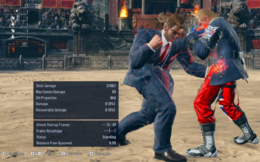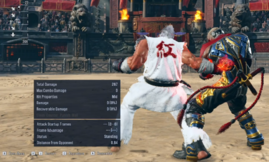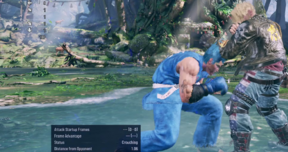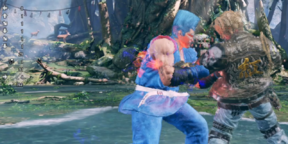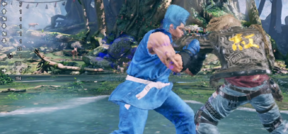m (→Deathfist) |
|||
| (111 intermediate revisions by the same user not shown) | |||
| Line 1: | Line 1: | ||
{{Navbox Paul}} | {{Navbox Paul}} | ||
{{Navbox tech}} | |||
== Sway Cancel > Deathfist == | |||
[[File:Resplat.mp4|loop|320x180px|right]] | |||
<big>(df+1_3,2_ws1,2)~b~u > qcf+2</big> | |||
Max damage wall ender. Input can be broken into three parts: | |||
# Sway cancel (ex. df+1~b) | |||
# Step cancel (ex. df+1~b~u) | |||
# qcf+2 | |||
=== Sway Cancel === | |||
Sway cancel windows are different for each of Paul's three cancelable attacks. B can be held at any point after the attack input and will result in a sway cancel if it remains held when the input window begins. Sway will start up on the same frame regardless of when the cancel input was performed. | |||
{| class="wikitable" | |||
|+ Sway Input Windows | |||
|- | |||
! Attack !! Input Window !! From Impact || Window Size | |||
|- | |||
| df+1 || 2-14f, 16f<ref>Dead zone on frame 15</ref> || i-12 to i+0, i+2 || 15f | |||
|- | |||
| 3,2 || 43f<ref name="delay" /> || i+3 || 1f | |||
|- | |||
| ws1,2<ref>CH does not affect window timing</ref> || 39-44f<ref name="delay">Assumes no delay between attacks</ref> || i-1 to i+4 || 16f | |||
|} | |||
=== Step Cancel === | |||
Paul cannot transition directly between his sway and CS (qcf) stances, so he must first exit sway with a sidestep input (u). This can be buffered during the transitional frames following a sway cancel, when Paul is moving backward but not yet able to act. | |||
{| class="wikitable" | |||
|+ Sidestep Buffer Windows | |||
|- | |||
! Attack !! Buffer Window !! From Impact !! Window Size !! First Actionable Frame | |||
|- | |||
| df+1~b || 16-31f<ref>17-31 if b is input on frame 16</ref> || i+2 to i+17 || 16f || 32 | |||
|- | |||
| 3,2~b || 45-60f<ref name="delay" /> || i+2 to i+17 || 16f || 61 | |||
|- | |||
| ws1,2~b || 44-59f<ref name="delay" /> || i+4 to i+19 || 16f || 60 | |||
|} | |||
'''Buffer window notes:''' | |||
* Additional directional inputs will overwrite u and no sidestep will be performed | |||
* Attack inputs will overwrite u and the corresponding SWA attack will be performed | |||
* Some attack + directional inputs will overwrite u and no sidestep or attack will be performed | |||
* 1f delay required between b and u inputs | |||
Because the buffer can only hold one command, beginning a qcf+2 input before the first actionable frame will result in a non-Deathfist attack (usually SWA.2 or f+2, depending on timing). | |||
=== Deathfist === | |||
Realignment and/or leftward movement may be required as Deathfist can whiff off axis. | |||
'''Against smaller characters, the slightly less damaging 1 > df+1~b > Deathfist or simply df+1~b > Deathfist is necessary as ws1,2~b > Deathfist and 3,2~b > Deathfist are either extremely difficult or impossible.''' | |||
<big>'''Valid Inputs'''</big> | |||
{{Legend | |||
|float=right | |||
|blue=Startup | |||
|yellow=Sway Window | |||
|orange=Step Window | |||
|teal=Standing/Stepping | |||
|purple=Crouch | |||
}} | |||
<div style="display: flex; flex-flow: row wrap; gap: 0 1em"> | |||
{{FrameTable|caption=Earliest df1~b > Deathfist (46f)| | |||
{{Frame|1|d/f1|teal}} | |||
{{Frame|2|b|yellow}} | |||
{{Frame|…||yellow}} | |||
{{Frame|16|u|orange}} | |||
{{Frame|…||orange}} | |||
{{Frame|32|d|teal}} | |||
{{Frame|33|d/f|purple}} | |||
{{Frame|34|f2|purple}} | |||
}} | |||
{{FrameTable|caption=Earliest 3,2~b > Deathfist (75f)| | |||
{{Frame|1|3|teal}} | |||
{{Frame|2|2|blue}} | |||
{{Frame|…||blue}} | |||
{{Frame|43|b|yellow}} | |||
{{Frame|…||yellow}} | |||
{{Frame|45|u|orange}} | |||
{{Frame|…||orange}} | |||
{{Frame|61|d|teal}} | |||
{{Frame|62|d/f|purple}} | |||
{{Frame|63|f2|purple}} | |||
}} | |||
{{FrameTable|caption=Earliest ws1,2~b > Deathfist (74f)| | |||
{{Frame|1|d|teal}} | |||
{{Frame|2|d/f|purple}} | |||
{{Frame|3|b|purple}} | |||
{{Frame|4|1|teal}} | |||
{{Frame|5|2|blue}} | |||
{{Frame|…||blue}} | |||
{{Frame|39|b|yellow}} | |||
{{Frame|…||yellow}} | |||
{{Frame|44|u|orange}} | |||
{{Frame|…||orange}} | |||
{{Frame|60|d|teal}} | |||
{{Frame|61|d/f|purple}} | |||
{{Frame|62|f2|purple}} | |||
}} | |||
</div> | |||
<big>'''Invalid Inputs'''</big> | |||
<div style="display: flex; flex-flow: row wrap; gap: 0 1em"> | |||
{{FrameTable|caption=2f early (SWA.2)| | |||
{{Frame|1|3|teal}} | |||
{{Frame|2|2|blue}} | |||
{{Frame|…||blue}} | |||
{{Frame|41|b|yellow}} | |||
{{Frame|…||yellow}} | |||
{{Frame|50|u|orange}} | |||
{{Frame|…||orange}} | |||
{{Frame|58|d|orange}} | |||
{{Frame|59|d/f|orange}} | |||
{{Frame|60|f2|orange}} | |||
}} | |||
{{FrameTable|caption=1f early (f+2)| | |||
{{Frame|1|3|teal}} | |||
{{Frame|2|2|blue}} | |||
{{Frame|…||blue}} | |||
{{Frame|41|b|yellow}} | |||
{{Frame|…||yellow}} | |||
{{Frame|50|u|orange}} | |||
{{Frame|…||orange}} | |||
{{Frame|59|d|orange}} | |||
{{Frame|60|d/f|teal}} | |||
{{Frame|61|f2|purple}} | |||
}} | |||
</div> | |||
<references/> | |||
=== External Links === | |||
* [https://www.youtube.com/watch?v=FEDx_cVRDOQ Master Paul's Hardest 3 2 Back Sway Death Fist Wall Combo || Easy Guide] by Mwkan | |||
== Buffered 2 > wr2 == | == Buffered 2 > wr2 == | ||
[[File:2wr2buffer 2.mp4|right|loop|320x180px]] | |||
[[ | An instant while running move cannot be fully buffered, but its first f,n input can. With a [[Input_buffer#Motion inputs|22-frame buffer window]] for while running attacks, f,n can be input extremely early during a 2 jab (as early as frame 10) and still result in a valid wr2 if the remaining commands are performed quickly enough after the 2 jab recovery ends. | ||
Taking advantage of this large window makes the 2 > wr2 combo easier by effectively splitting its input into halves, with only the second set of inputs (f,n,f,f+2) requiring any precision in their timing. | |||
{{Legend | {{Legend | ||
| Line 16: | Line 151: | ||
|purple=Dashing | |purple=Dashing | ||
}} | }} | ||
<div style="display: flex; flex-flow: row wrap; gap: 0 1em"> | |||
{{FrameTable|caption=Earliest 2 > wr2 with buffered f,n (33f)| | {{FrameTable|caption=Earliest 2 > wr2 with buffered f,n (33f)| | ||
{{Frame|1|n2|blue}} | {{Frame|1|n2|blue}} | ||
| Line 40: | Line 176: | ||
{{Frame|51|f2|purple}} | {{Frame|51|f2|purple}} | ||
}} | }} | ||
</div> | |||
Note that these are only examples meant to show the upper | |||
Note that these are only examples meant to show the upper bounds of the buffer window. Frame-perfect inputs are rarely, if ever, required for a successful 2 > wr2 link. | |||
== Resplat == | == Resplat == | ||
[[File:Resplat.mp4|loop|320x180px|right]] | [[File:Resplat.mp4|loop|320x180px|right]] | ||
<big>Splat > Reposition > Splat > qcf+3+4 > d+1+2 > Ender</big> | |||
* First splat must be a wall-hitting combo starter that causes opponent to enter a forward-falling slide state | * First splat must be a wall-hitting combo starter that causes opponent to enter a forward-falling slide state | ||
* Reposition so that the next attack splats as high as possible — one backdash is the most common solution, but some splat angles require lateral, delayed or forward movement | * Reposition so that the next attack splats as high as possible — one backdash is the most common solution, but some splat angles require lateral, delayed or forward movement | ||
* Second splat requires qcf+1 or u/ub/uf+3+4 to keep opponent high enough on wall for followups | * Second splat requires qcf+1 or u/ub/uf+3+4 to keep opponent high enough on wall for followups | ||
== 1+2 Fast Cancel == | == 1+2 == | ||
{{MoveDataHeader}} | |||
{{MoveQuery|Paul-1+2}} | |||
=== 1+2 Fast Cancel === | |||
[[File:1p2cancel 1.mp4|right|loop|320x180px]] | [[File:1p2cancel 1.mp4|right|loop|320x180px]] | ||
<big>1+2 (hold 17-35f) > f~u~b (release 1+2)</big> | |||
Create space or force reactions from a relatively safe position. Lock down defensive players and bait offensive players, all without actually attacking. H.1+2 cancels do not consume Heat. | |||
1+2 can be canceled between 17 and 35 frames of charge. Canceling forward into CS requires a minimum commitment of 27 frames. Canceling backward into SWA requires a minimum of 41f. Both stances can be further canceled into Deep Dive with df. | |||
While Paul has direct access to SWA and CS attacks from 1+2 cancels, and these moves can be effective, both are subject to delayed startup compared to their normal use. This can be avoided by fast canceling into QCF or QCB and then performing the move. | |||
'''Usage:''' | |||
{| class="wikitable mw-collapsible mw-collapsed" | |||
! colspan=1 | Fast cancel to condition opponents into disrespecting charge, then release. | |||
|- | |||
| [[File:1p2_24.mp4|loop|center|autoplay]] | |||
|} | |||
{| class="wikitable mw-collapsible mw-collapsed" | |||
! colspan=1 | Fast cancel into grabs or lows to catch opponents looking to block a 1+2 release. | |||
|- | |||
| [[File:1p2 4.mp4|loop|center|autoplay]] | |||
|} | |||
{| class="wikitable mw-collapsible mw-collapsed" | |||
! colspan=1 | Fast cancel into sidestep, block, or a preemptive attack to punish committal counters. | |||
|- | |||
| [[File:1p2fc 1.mp4|loop|center|autoplay]] | |||
|} | |||
{| class="wikitable mw-collapsible mw-collapsed" | |||
! colspan=1 | Fast cancel into another fast cancel for maximum mindgames. | |||
|- | |||
| [[File:1p2qcf1p2 1.mp4|loop|center|autoplay]] | |||
|} | |||
=== H.1+2* Wall Reset === | |||
[[File:H1p2 10.mp4|right|loop|300x160px]] | |||
<big>W! > (df+1_ws1,2_3,2)~b~u > H.1+2 (charge)</big> | |||
H.1+2*, particularly at the wall, is a powerful and criminally underrated alternative to H.b+2,1* and H.d+1,2*. End your wall combo with any sway cancel (df1~b, ws1,2~b, 3,2~b) and instead of finishing with a low wall hit, begin charging 1+2. | H.1+2*, particularly at the wall, is a powerful and criminally underrated alternative to H.b+2,1* and H.d+1,2* setups. End your wall combo with any sway cancel (df1~b, ws1,2~b, 3,2~b) and instead of finishing with a low wall hit, begin charging 1+2. | ||
[[File:H1p2 4.mp4|right|loop|300x160px]] | |||
If the opponent techs, H.1+2 will be charged to level 2 by the time they return to a standing state. Time your H.1+2* release accordingly — it will catch techs to both sides due to its upgraded tracking — and convert a hit into 70-100 damage depending on the splat angle. | If the opponent techs, H.1+2 will be charged to level 2 by the time they return to a standing state. Time your H.1+2* release accordingly — it will catch techs to both sides due to its upgraded tracking — and convert a hit into 70-100 damage depending on the splat angle. | ||
[[File:H1p2 wall reset 3.mp4|right|loop|300x160px]] | |||
If the opponent does block H.1+2* at the wall, they will take 17 chip damage and a -17g wall crush. At this point, Paul's pressure options become nearly uninterruptible. Continued blocking will pile on chip damage and a variety of hits can lead to splat combos. | |||
The obvious counterplay to this technique is remaining grounded and punishing H.1+2* on whiff. Delayed tech after the high wall hit (up to 20f) can complicate setup timing. Toe kick is another effective counter, but it can be baited and launched on block. | |||
Against opponents familiar with this setup, advantageous mindgame layers can be added by fast canceling 1+2 into block, grab, guard break, and so on. | |||
== Pauldash == | == Pauldash == | ||
[[File:Pauldash 2.mp4|right|loop|320x180px]] | [[File:Pauldash 2.mp4|right|loop|320x180px]] | ||
<big>d,df~d,df~u > repeat</big> | |||
Quickly cancel crouch dash into Deep Dive with df, crouch cancel Deep Dive with u, and repeat for Paul's pseudo-wavedash/snake dash. Much easier to execute reliably with some form of [[Backdash_cancel#Keyboard|SOCD cleaning]]. | Quickly cancel crouch dash into Deep Dive with df, crouch cancel Deep Dive with u, and repeat for Paul's pseudo-wavedash/snake dash. Much easier to execute reliably with some form of [[Backdash_cancel#Keyboard|SOCD cleaning]]. | ||
Pair with sidesteps for oki approaches (DPD will realign and chase down techs to either side) and quick ws1,2/DPD.4 mid-range pressure (high evasion from CD/DPD can create whiffs against some keepout buttons). | |||
When using in neutral, be aware of Deep Dive's [[Paul_tech#Deep_Dive_Startup_Delay/Input_Lockout|startup delay and input lockout]], which can give opponents enough time to recognize and challenge your approach. | |||
== BT Tech Trap == | == BT Tech Trap == | ||
| Line 97: | Line 263: | ||
:'''[+99]''' ws1,2~b > SWA.1+2 > 3,2~b > SWA.1+2 T! > H.qcf+2~f > qcf+2 | :'''[+99]''' ws1,2~b > SWA.1+2 > 3,2~b > SWA.1+2 T! > H.qcf+2~f > qcf+2 | ||
}} | }} | ||
Forward jumping against a backturned opponent in Tornado state can force tech attempts to recover backturned. | Forward jumping against a backturned opponent in Tornado state can force tech attempts to recover backturned. | ||
| Line 110: | Line 278: | ||
* d, df, d, df, (4f delay), ws1 startup is i21~22 | * d, df, d, df, (4f delay), ws1 startup is i21~22 | ||
* d, df, d, df, (5f delay), ws1 startup is i20-21 | * d, df, d, df, (5f delay), ws1 startup is i20-21 | ||
And so on until 9f delay (10f after DPD), when ws1 startup is back to the regular i15~16. | And so on until 9f delay (10f after DPD), when ws1 startup is back to the regular i15~16. Essentially, Deep Dive triggers an immediate 9-frame recovery window on activation. | ||
The Frame Data display in Practice/Replay mode does not account for these additional frames and shows only the attack's normal startup. | The Frame Data display in Practice/Replay mode does not account for these additional frames and shows only the attack's normal startup. | ||
Latest revision as of 04:49, 26 June 2024
| Paul |
|---|
| Tech (Tekken 8) |
|---|
Sway Cancel > Deathfist
(df+1_3,2_ws1,2)~b~u > qcf+2
Max damage wall ender. Input can be broken into three parts:
- Sway cancel (ex. df+1~b)
- Step cancel (ex. df+1~b~u)
- qcf+2
Sway Cancel
Sway cancel windows are different for each of Paul's three cancelable attacks. B can be held at any point after the attack input and will result in a sway cancel if it remains held when the input window begins. Sway will start up on the same frame regardless of when the cancel input was performed.
| Attack | Input Window | From Impact | Window Size |
|---|---|---|---|
| df+1 | 2-14f, 16f[1] | i-12 to i+0, i+2 | 15f |
| 3,2 | 43f[2] | i+3 | 1f |
| ws1,2[3] | 39-44f[2] | i-1 to i+4 | 16f |
Step Cancel
Paul cannot transition directly between his sway and CS (qcf) stances, so he must first exit sway with a sidestep input (u). This can be buffered during the transitional frames following a sway cancel, when Paul is moving backward but not yet able to act.
| Attack | Buffer Window | From Impact | Window Size | First Actionable Frame |
|---|---|---|---|---|
| df+1~b | 16-31f[4] | i+2 to i+17 | 16f | 32 |
| 3,2~b | 45-60f[2] | i+2 to i+17 | 16f | 61 |
| ws1,2~b | 44-59f[2] | i+4 to i+19 | 16f | 60 |
Buffer window notes:
- Additional directional inputs will overwrite u and no sidestep will be performed
- Attack inputs will overwrite u and the corresponding SWA attack will be performed
- Some attack + directional inputs will overwrite u and no sidestep or attack will be performed
- 1f delay required between b and u inputs
Because the buffer can only hold one command, beginning a qcf+2 input before the first actionable frame will result in a non-Deathfist attack (usually SWA.2 or f+2, depending on timing).
Deathfist
Realignment and/or leftward movement may be required as Deathfist can whiff off axis.
Against smaller characters, the slightly less damaging 1 > df+1~b > Deathfist or simply df+1~b > Deathfist is necessary as ws1,2~b > Deathfist and 3,2~b > Deathfist are either extremely difficult or impossible.
Valid Inputs
| Startup | |
| Sway Window | |
| Step Window | |
| Standing/Stepping | |
| Crouch |
Invalid Inputs
External Links
Buffered 2 > wr2
An instant while running move cannot be fully buffered, but its first f,n input can. With a 22-frame buffer window for while running attacks, f,n can be input extremely early during a 2 jab (as early as frame 10) and still result in a valid wr2 if the remaining commands are performed quickly enough after the 2 jab recovery ends.
Taking advantage of this large window makes the 2 > wr2 combo easier by effectively splitting its input into halves, with only the second set of inputs (f,n,f,f+2) requiring any precision in their timing.
| Startup | |
| Active | |
| Recovery | |
| Standing | |
| Dashing |
Note that these are only examples meant to show the upper bounds of the buffer window. Frame-perfect inputs are rarely, if ever, required for a successful 2 > wr2 link.
Resplat
Splat > Reposition > Splat > qcf+3+4 > d+1+2 > Ender
- First splat must be a wall-hitting combo starter that causes opponent to enter a forward-falling slide state
- Reposition so that the next attack splats as high as possible — one backdash is the most common solution, but some splat angles require lateral, delayed or forward movement
- Second splat requires qcf+1 or u/ub/uf+3+4 to keep opponent high enough on wall for followups
1+2
Input
1+2
- H.1+2 with Heat
- Move can be delayed 11f (i39)
- Charge begins on frame 1
- Requires 1~27f charge
- Delayed startup from 17~27f charge
- Cancel to t27 r1 CS from 17~35f with f
- Cancel can be delayed 8f
- Sidestep u can be buffered 2f after cancel
- CS attacks can be buffered from 26f
- Decaying 13f delay on CS attacks
- Decays to 0 delay 24f after cancel
- Cancel to t41 r12 SWA from 17~35f with b
- Cancel can be delayed 8f
- Sidestep u can be buffered from 27f
- SWA attacks can be buffered from 26f
- 1+2* from 28~55f charge
- Burning Fist at 56f charge
1+2 Fast Cancel
1+2 (hold 17-35f) > f~u~b (release 1+2)
Create space or force reactions from a relatively safe position. Lock down defensive players and bait offensive players, all without actually attacking. H.1+2 cancels do not consume Heat.
1+2 can be canceled between 17 and 35 frames of charge. Canceling forward into CS requires a minimum commitment of 27 frames. Canceling backward into SWA requires a minimum of 41f. Both stances can be further canceled into Deep Dive with df.
While Paul has direct access to SWA and CS attacks from 1+2 cancels, and these moves can be effective, both are subject to delayed startup compared to their normal use. This can be avoided by fast canceling into QCF or QCB and then performing the move.
Usage:
| Fast cancel to condition opponents into disrespecting charge, then release. |
|---|
| Fast cancel into grabs or lows to catch opponents looking to block a 1+2 release. |
|---|
| Fast cancel into sidestep, block, or a preemptive attack to punish committal counters. |
|---|
| Fast cancel into another fast cancel for maximum mindgames. |
|---|
H.1+2* Wall Reset
W! > (df+1_ws1,2_3,2)~b~u > H.1+2 (charge)
H.1+2*, particularly at the wall, is a powerful and criminally underrated alternative to H.b+2,1* and H.d+1,2* setups. End your wall combo with any sway cancel (df1~b, ws1,2~b, 3,2~b) and instead of finishing with a low wall hit, begin charging 1+2.
If the opponent techs, H.1+2 will be charged to level 2 by the time they return to a standing state. Time your H.1+2* release accordingly — it will catch techs to both sides due to its upgraded tracking — and convert a hit into 70-100 damage depending on the splat angle.
If the opponent does block H.1+2* at the wall, they will take 17 chip damage and a -17g wall crush. At this point, Paul's pressure options become nearly uninterruptible. Continued blocking will pile on chip damage and a variety of hits can lead to splat combos.
The obvious counterplay to this technique is remaining grounded and punishing H.1+2* on whiff. Delayed tech after the high wall hit (up to 20f) can complicate setup timing. Toe kick is another effective counter, but it can be baited and launched on block.
Against opponents familiar with this setup, advantageous mindgame layers can be added by fast canceling 1+2 into block, grab, guard break, and so on.
Pauldash
d,df~d,df~u > repeat
Quickly cancel crouch dash into Deep Dive with df, crouch cancel Deep Dive with u, and repeat for Paul's pseudo-wavedash/snake dash. Much easier to execute reliably with some form of SOCD cleaning.
Pair with sidesteps for oki approaches (DPD will realign and chase down techs to either side) and quick ws1,2/DPD.4 mid-range pressure (high evasion from CD/DPD can create whiffs against some keepout buttons).
When using in neutral, be aware of Deep Dive's startup delay and input lockout, which can give opponents enough time to recognize and challenge your approach.
BT Tech Trap
- [86] H.qcf+2 WBl! > SSL~F > SSL > qcf+1 (x3) > SWA.1+2 T! > dash > UF
- [+99] ws1,2~b > SWA.1+2 > 3,2~b > SWA.1+2 T! > H.qcf+2~f > qcf+2
Forward jumping against a backturned opponent in Tornado state can force tech attempts to recover backturned.
Deep Dive Startup Delay/Input Lockout
There is a 10-frame window after Deep Dive where Paul's movement is locked and attack options (both ws and DPD) start up 1-10 frames slower.
An immediate press after DPD (ws1/ws2/ws3/ws4/DPD.2/DPD.4/DPD.3+4) will add 10 frames of startup to that move. This delay decays gradually for each frame following the DPD input, until startup eventually returns to normal. For example:
- ws1 startup is i15~16
- d, df, d, df, ws1 startup is i25~26
- d, df, d, df, (4f delay), ws1 startup is i21~22
- d, df, d, df, (5f delay), ws1 startup is i20-21
And so on until 9f delay (10f after DPD), when ws1 startup is back to the regular i15~16. Essentially, Deep Dive triggers an immediate 9-frame recovery window on activation.
The Frame Data display in Practice/Replay mode does not account for these additional frames and shows only the attack's normal startup.
This decaying startup delay is similar to that of sidestep moves, but with the additional constraint that Paul's only bufferable movement in this state is u (which cannot be used to immediately crouch cancel - see next section for details).
Lockout frames begin as soon as the initial crouch dash is canceled into Deep Dive. Delay between CD/QCF and DPD inputs does not seem to matter.
This delay makes Deep Dive a more committal approach than Paul's regular crouch dash and has practical drawbacks in both neutral and pressure. Be mindful of this extra startup before attacking with a long-range iWS1,2 or DPD.2, and avoid using DPD inputs for iWS at closer ranges whenever possible.
-
iWS1 (normally i15~16) hits on frame 25 when input immediately after Deep Dive.
-
DPD.2 (normally i15) hits on frame 25 when input immediately after Deep Dive.
-
Paul cannot block in the 9-frame lockout window following a Deep Dive input.
Crouch Cancel Does Not Avoid Lockout
Crouch canceling to avoid the DPD delay window and immediately return to neutral does not seem possible. The sidestep from an up input can only be buffered and executed 10 frames after DPD at the earliest. No other directional movement or attack can be buffered, and some inputs may lead to unintentional jumps (this appears to be a bug).
This includes b and d, meaning you cannot block for at least 10 frames after DPD.
-
Mids cannot be blocked during the lockout window.
-
Highs will still be evaded.
